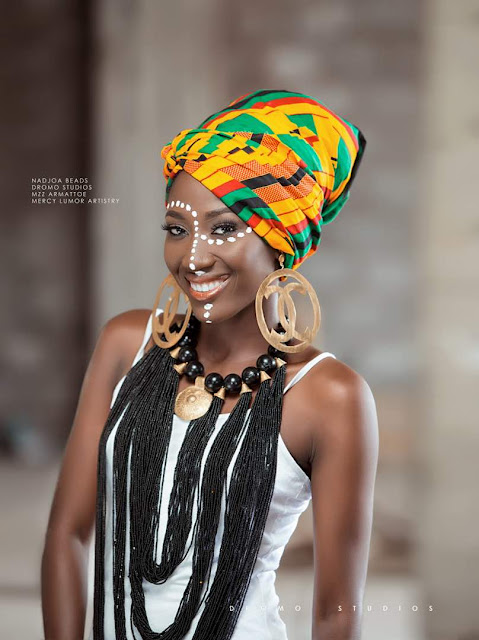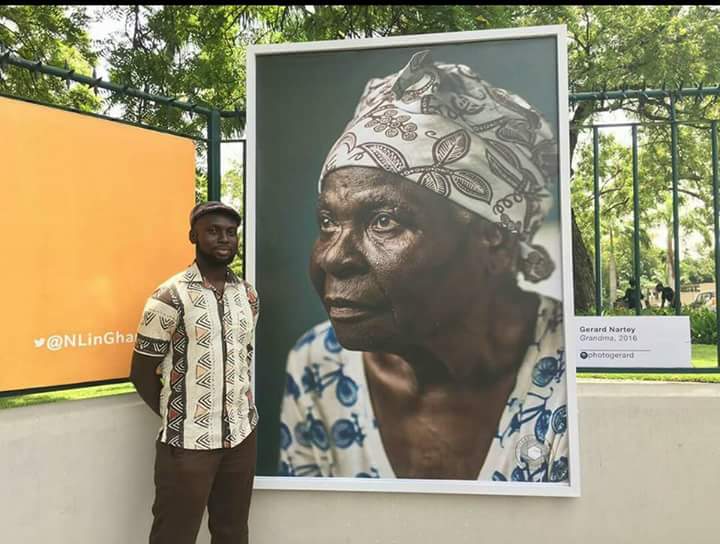NAJOA BEADS: African Woman Uniting Cultures through Beads
Centuries ago the African woman discovered the bead from the earth (though its origin is not limited to Africa). This jewelry would be the creative expression and heritage for women of African for centuries. It has been a traded commodity between the Arabic merchants and the Saharan empires (including the Ghana & Songi empires) before the European colonization. The trading of beads is still active today.
This exhortation of the artistry of beads has been laced with the story of a particular bead maker. In the Ghanaian artistic industry, no one exhausts the artistry of beads than Nadjoa Beads.
Nadjoa Beads chooses her beads from different origins to make her work exceptional. Koffie beads from Nigeria, crystal beads from China, gem stones from India, glass beads, bronze beads from Ghana, frosted bead, seed beads, coral beads, shells, Ghanaian clay beads, amber beads, unique stones appearing in nature and leather necklace from Mali (which she enhances into beads).
We are undergoing an explosion of innovation, unity and creativity with the African beads. What seemed to be an ornament to accessorize fashion has become the fashion itself.
It is in our nature as human beings to unite. We are united in several ways: in music, art, science and religion. The most unexpected place to find such diversity and unity is in beads craft, yet here we are.
According to her, “Mixing beads from all over the world; that is what I am really portraying in my beads. I am trying to unit cultures. If I want to deal with people from different cultures then you have to have an open mindset and ready to accept their opinions,” she confesses.
She explained that, “I am getting positive responds not from Ghanaians alone but also outside the country. Because, they see you [referring to herself] mixing elements that remind them a little bit of their home countries, [as well as] a little bit of something that reminds them of what they saw in other countries.”
The use of colors, forms and shapes are all too familiar with the creative arts. To discover a conscious application of these elements in traditional bead crafts revives admiration of the ingenuity of the African woman. Strange as some may find it, this is how peculiar Nadjoa Beads are.
I took time to ask the creative director of Nadjoa Beads what she likes about beads in general; her response was, “Honestly, I think the colors, and the shapes of the beads. I came across some stones once and I was surprise to know that some beads were actually made from stones. This is natural, this is nature and this is good. I love nature and anything that has to do with nature. I started working with the stones because I found it very unique and very nice. I started venturing in other designs. But seriously I didn’t learn the beading, it came naturally.”
Nadjoa never learnt how to string beads from anyone. Just as several generations of African women were socialized into bead making (by simply seeing what the older generation does) her skills was acquired and horned through observation. In her days at Cape Coast University, she had been ventured into making earrings from fabrics. The skill she craftily nicked by watching her friend (a fashion design student at the time). “Though I stole the idea, it was an advantage for me and it was worth it. It led me on this journey of self-discovery.”
Who knows crafting beads can teach you the human character of patience, human relation, integrity and the ability to learn on your own. “I never did human relations but I realized I’m good at it now. That is what I learnt doing this business. I never knew I could be that patient not until I starting making beads (Some customers are very controversial, you know). Personal integrity. It is better to let the person go than to say ‘oh yes, I can do it for you and then you can’t do it. Nobody will accept that. That is some of the things I learnt about myself.”
According to her, “In school I was making earrings with fabrics to sell to some students. In doing that I started growing passionate about it, I realized that I like to work with my hand, and I loved to work with colours. Anything I did amazed me,” she added. Feeding off people’s compliments, her confidence solidifies. “It made me so happy that I had to do something for somebody to appreciate.”
Beads are essential and characteristic of the Ghanaian culture (I can’t speak for other African cultures). Mothers pass on beads to their children before they marry. Till date, beads are listed in the dowries too. Bracelets, necklaces, earrings, anklets and waist beads are some of the beads that make up part of the feminine adornment in Ghana. The stereotype in some Ghanaian art was to portray the African woman in waist bead and an anklets.
The rise of Christianity in a highly superstitious society especially Ghana, beads has begun to receiving bad publicity. The Nigerian cinemas in Ghana sowed images of witches passing on their witchcrafts to their children through their beads.
However, things are changing. Beads are receiving attention these days. The market is saturated by other bead makers. The likes of Nadjoa Beads are feeding into the urban psyche that beads are the new modernity. The middle class women and corporate women have carved niche market for beads.
I was privileged to speak with Elizabeth, a patron with a passionate and critical taste in beads. In my interview. “I love her bead because I am creative. I am carried away by anything that brings my creative self.” Elizabeth said. She illustrates how she chooses her beads depending on how she wants to look. “It depends on what you are wearing it with; if you want a formal look she has bead for it.” Before our interview she had spent about an hour and half choosing some beads. Even after all that, she had to video called a friend for a second opinion.
Nadjoa’s beads have featured on the runway of Accra Fashion Week, 2018. The most interesting was a cape made of golden brown beads over a black long dress adorn by an elegant model. Even with these achievements she is still pushing her limits to invent new things. So far she made key holders, broaches, Tissue boxes made of beads, earrings etc.
I believe I am limitless and everything is possible. So why not do different things, why not explore with your passion rather than limiting yourself to one thing.”
Her next project will be a dress made of beads. The whole idea for her is to explore what she could do with beads. “If it’s really your talent, you have to show us other things you can do with it” she said, after she stressed that she naturally gets bored repeating designs.
How does she do all these elegant beads? It all starts with selecting the right beads. “I virtually take time to go through all the shops I know in Accra to make sure what I’m buying is not something that is common every where.” She noted. With the beads, she then thinks of the design that presents itself. She picks the expensive beads to lay emphasis on and strings all the elements together.
“In making your work very unique, you need to make a design that has one element that is not on the market. That is my trick.”
The simplicity of beads makes its beauty a jewelry of the land. This is where it derives its true value; a precious gem given by nature. Beads have come full circle, having been handed down form grandmothers to grandchildren. If this trend continues, the bead craft will become an ever evolving culture, continuing to undergo redefinition.












Comments
Post a Comment